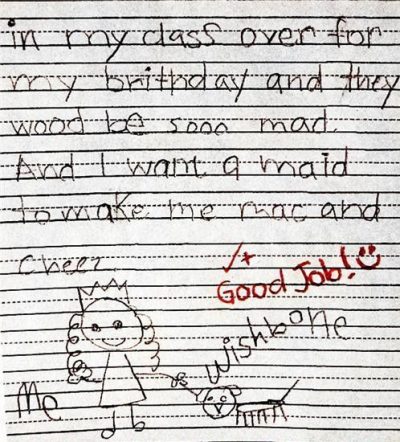Its a question that crops up many many times from teachers – so if it’s troubling you then you are not the only one!
The problem is not so much as getting work done, as it is in getting QUALITY work done and ENOUGH WORK done!
So lets go back to previous articles and see what we should have put in place that will assist in this area and that we can extend to work produced in the classroom.
I have mentioned previously about
- Being organised in class
- Setting clear expectations with regard to EVERY aspect of classroom life.
The key component of both of these things is that the children know and understand what is expected of them and what you will accept and what you wont. It should permeate everything that happens in your class.
Lets take a simple example – ” Rule off from your last piece of work, put todays date and then put the title on the next line in the middle and underline it”.
While this is happening you will be walking around to check that everybody is carrying this out in exactly the way you have asked. So if the date is on the wrong side of the page, the title is not on the next line down or the ruling is untidy then you will say “rub it out and do it again”.
Simple, clear and effective – after a couple of minutes ask the children to put down their pencils as YOU are ready to start. (irrespective of whether they have finished their writing or not)
See how we are shaping up….this is what I expect and this is what you will do…..easy !
So applying the same approach to the work the children are doing.
Before I start to explain how to approach this, let me begin by making a few personal observations and comments about childrens’ work.
- From Reception class upwards I would expect to see a gradual and proportional increase in the written work of children.
- There is a temptation for many teachers to be too reliant on photocopied work that the children simply have to complete – whilst photocopied work may be appropriate at times it should not be overused as children need to learn to plan, set out, write, draw and complete written work as skills in themselves.
- If this is not done then as a teacher you cannot complain if the children in your class cannot write or complete written work to any standard, and also more pressingly, to any speed.
- Children also need to learn the self discipline to work within given constraints of time and acceptable quality.
Ok back to the classroom and getting the work done….
There are generally 2 distinct parts to a lesson (without getting too politically correct and talking about warmups and plenary’s!)
- The introduction to that particular lesson which may involve explanations by the teacher and discussion with the class. Members of the class may be involved in writing on the board / screen but this part of the lesson is usually introducing and discussing “new things”.
- The second part of a lesson would then take this further and would set work for the children to do based on what has been discussed and illustrated.
Ok so that’s a very big generalisation but I am sure you can identify the 2 sections in most of your lessons.
Here’s how I would approach it for written work (not photocopies).
The children would have been asked to write the date and title as previously explained and of course you would have moved around making sure it was done correctly. Pencils would have been put down ready for the next section of the lesson.
The teaching / class interaction and discussion would have taken place…..now from this I would identify the important things we “need to know and remember” and these would be written on the board / screen for the children to copy. (as these are vital pieces of information relating to the topic its important we all know them)
In addition I would be instructing the class, that where I underline things so do they, where I start a subheading so do they and where a drawing occurs then it has to be copied and labelled neatly. (I always tell them or mark on the page how many lines high it should be) If I miss a line out then I used to indicate at the right hand side by a x- which meant don’t write on that line!
I other words I am aiming for the children to copy neatly the “important facts we have just been discussing”.
Depending on the age / ability of the children obviously you as a teacher will decide what can be achieved and expected.

This written work will cover the discussion / teaching area for that lesson – or it may be that, having given the children a suitable length of time to complete that writing, they then put pencils down and you proceed to the next information section in the lesson – and the written work for that section is then completed. (you would tell the children how long they have to copy down the work before we move on)
Having completed the first part of the lesson, everyone now has the important facts written in their books and its time for the work based on what we have been talking about.
It may be a drawing, labelling or questions based on the previous facts …whatever you have set.
Having completed that lesson we now can see when we open the books –
- Neatly written work set out well
- Work properly titled and set out
- Important information about the subject area
- Written work to reinforce or consolidate things.
It looks good , its easy to read and it shows the children have taken care…..of course for those children who fail to finish the work or whose work is not to standard then they will have to finish or repeat the work in their own time (playtime or dinnertime).
Just as a sub note – whilst the children are writing make sure you move around the class checking the work standard and layout. Don’t accept anything that is not good enough. Remind the children how long is left for them to complete work and that anyone not finishing will have to stay to complete.
When the next lesson comes around on this topic you can, as a class, look back or read together the previous important facts that we covered last time. Then proceed to move forward.
In part 2 on this we will look at setting expectations and goals right across the curriculum and how you can ensure these are met.
Expect children initially to fail on many things….neatness, layout, time taken. But keep pushing and setting high expectations – they will get there in the end.
Charles


